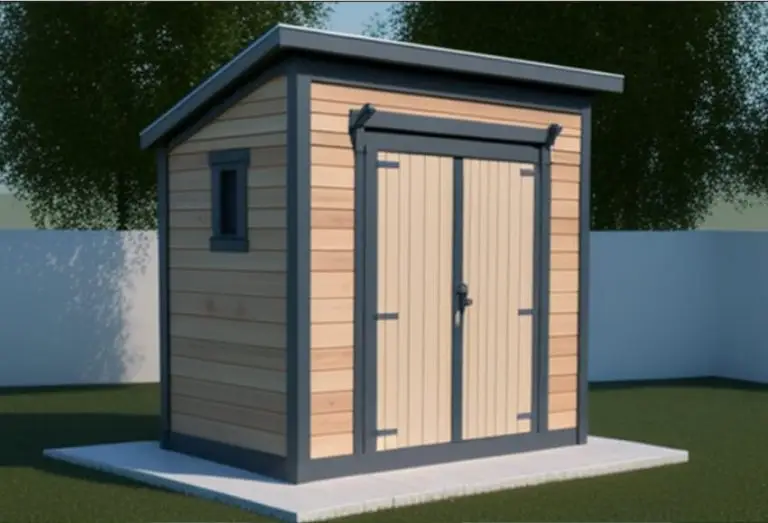Embarking on a DIY project to enhance your outdoor space can be both exciting and daunting. However, with the right lean to shed plans and a bit of guidance, you can transform your backyard into a functional and stylish area. Lean to sheds are not only space-saving and cost-effective but also versatile, serving as storage, a workshop, or even a cozy retreat. This ultimate guide is designed to walk you through every step of the lean to shed planning and construction process. Whether you’re a seasoned builder or a novice eager to tackle your first project, our comprehensive approach will ensure you have all the information you need to successfully design and construct your lean to shed. Let’s dive in and turn your vision into a reality.
What Is A Lean To Shed?
Lean to sheds, characterized by their single sloping roof attached to an existing structure, offer an efficient solution for adding storage or workspace to your property. These sheds are particularly appealing because of their straightforward design and the way they seamlessly integrate with your home or garage, creating a cohesive look. When considering lean to shed plans, it’s essential to weigh the advantages, such as cost-effectiveness and space efficiency, against potential drawbacks like limited size and design flexibility. Ideal locations for a lean to shed often include side yards or underused spaces along the exterior walls of a house, maximizing the utility of every square foot of your property.
Planning Your Project
Before diving into construction, successful lean to shed plans begin with thorough planning. This stage involves determining the shed’s size and dimensions, which should be based on your storage needs and the available space on your property. Material selection is crucial; whether you opt for wood, metal, or plastic will affect the shed’s durability, maintenance, and aesthetic appeal. Additionally, understanding local building codes and acquiring necessary permits is a must to ensure your project complies with regulations. Design considerations, such as roof slope for proper drainage and flooring materials for durability, play a significant role in the functionality of your shed.
Designing Your Lean To Shed
Designing your lean to shed is a creative process that allows you to customize the structure to fit your needs and preferences. Effective lean to shed plans incorporate basic design principles that enhance both the functionality and appearance of the shed. Utilizing tools and software for shed design can help visualize the final product, ensuring it meets your expectations. Moreover, thoughtful design decisions can make your shed a natural extension of your home, complementing its architectural style and blending with the surrounding landscape.
Preparing Your Site
A solid foundation is key to the longevity of your lean to shed, making site preparation an integral part of your lean to shed plans. Choosing the right location involves considering factors like ground stability, drainage, and accessibility. Once a site is selected, the ground must be cleared and leveled to provide a stable base for the shed. Depending on the shed’s size and design, laying a foundation using concrete slabs or wooden frames can provide the necessary support and prevent future issues related to moisture or uneven settling. Check out our article on foundations here.
Time For Construction
The construction phase is where your lean to shed plans come to life. Starting with building a sturdy frame, this step-by-step process involves careful attention to detail and adherence to the design specifications. Erecting the roof structure and covering it with the chosen material ensures protection from the elements. Installing doors and windows not only adds functionality but also ventilation and natural light. Final touches, such as painting and sealing, not only enhance the shed’s appearance but also protect it from weathering and wear. I found this video that covers construction.
Customization and Decoration
Customization and decoration are what truly personalize your lean to shed, making these elements vital components of your lean to shed plans. Interior customizations like shelving and hooks can maximize storage efficiency and organization. Exterior decorations, from paint colors to landscaping, can enhance the shed’s aesthetic appeal and ensure it complements your home and garden. Regular maintenance, including painting and checking for damage, will keep your shed looking great and functioning well for years to come.
Common Mistakes to Avoid

Awareness of common mistakes is crucial when following lean to shed plans. Overlooking the importance of a solid foundation, underestimating material costs, and neglecting to secure proper permits are pitfalls that can derail your project. This section of the guide emphasizes the importance of detailed planning, accurate budgeting, and adherence to local regulations to avoid costly and time-consuming corrections down the line.
How Close To The Soffit To Put A Lean To Shed?
When planning the placement of a lean to shed in relation to your home, especially considering how close to the soffit (the underside of the roof overhang) the shed should be, there are several critical factors to consider. Ideally, the shed should be positioned so that it does not impede airflow around the soffit vents, which are crucial for maintaining proper attic ventilation. This means leaving enough space between the top of the shed and the soffit to allow air to circulate freely. Additionally, you’ll want to ensure that the shed does not redirect water towards the house, which could lead to potential moisture issues.
Typically, a gap of at least 12 to 18 inches from the soffit is recommended to prevent these issues, though this can vary based on the specific design of your house and shed. This spacing not only helps in maintaining the structural integrity and longevity of both the shed and your home but also in adhering to building codes and regulations that may specify minimum distances for such constructions. Consulting with local building authorities or a construction professional when planning your lean-to shed can provide tailored advice for your particular situation, ensuring that your shed is both functional and compliant.
Legal Considerations and Safety
Lean to shed plans must also address legal considerations and safety. Ensuring that your shed complies with local zoning laws and building codes is essential to avoid legal complications. Safety during construction is paramount; wearing protective gear, following manufacturer instructions for tools and materials, and being mindful of ergonomic practices can prevent accidents and injuries. You can look up your local zoning laws here.
Summary
Hopefully this comprehensive guide serves as your all-in-one resource for designing and constructing a lean to shed. Whether you’re a seasoned DIYer or a novice looking to tackle your first outdoor project, this guide should demystify the complexities of shed construction, providing you with the confidence and knowledge needed to create a functional and aesthetically pleasing lean to shed. Start planning and building your shed to transform your backyard into a more organized, inviting area for relaxation and storage.
All The Best,
JB
Check Out Our Shed Plans Below To Get Started.


